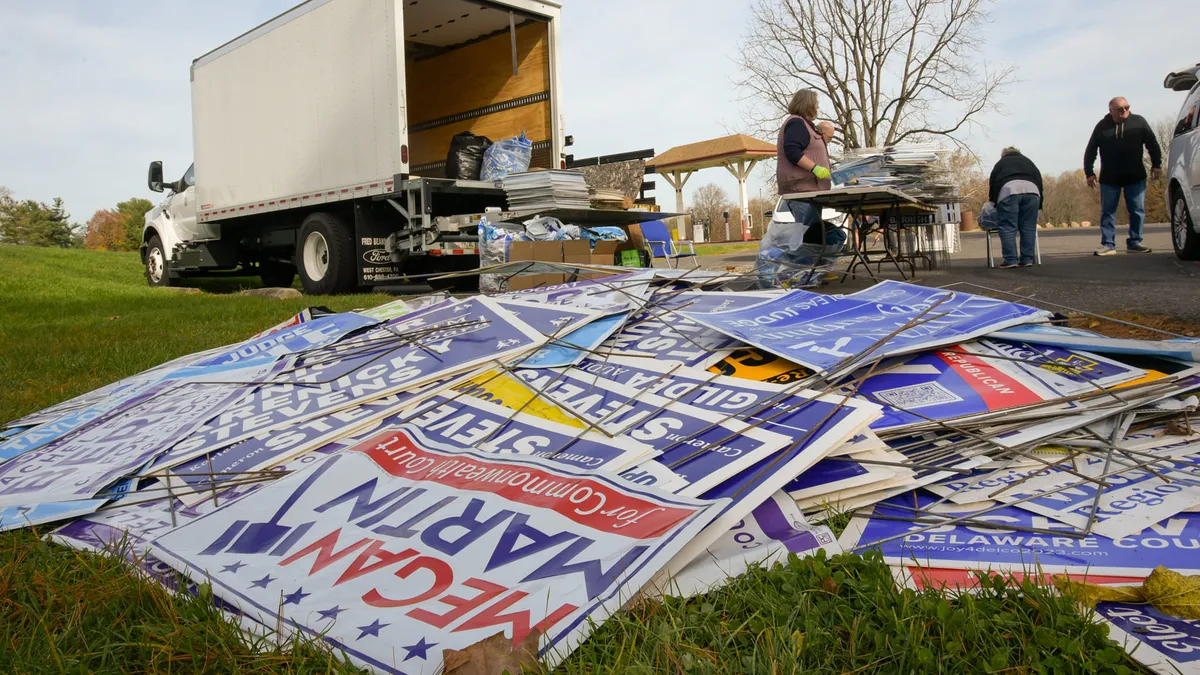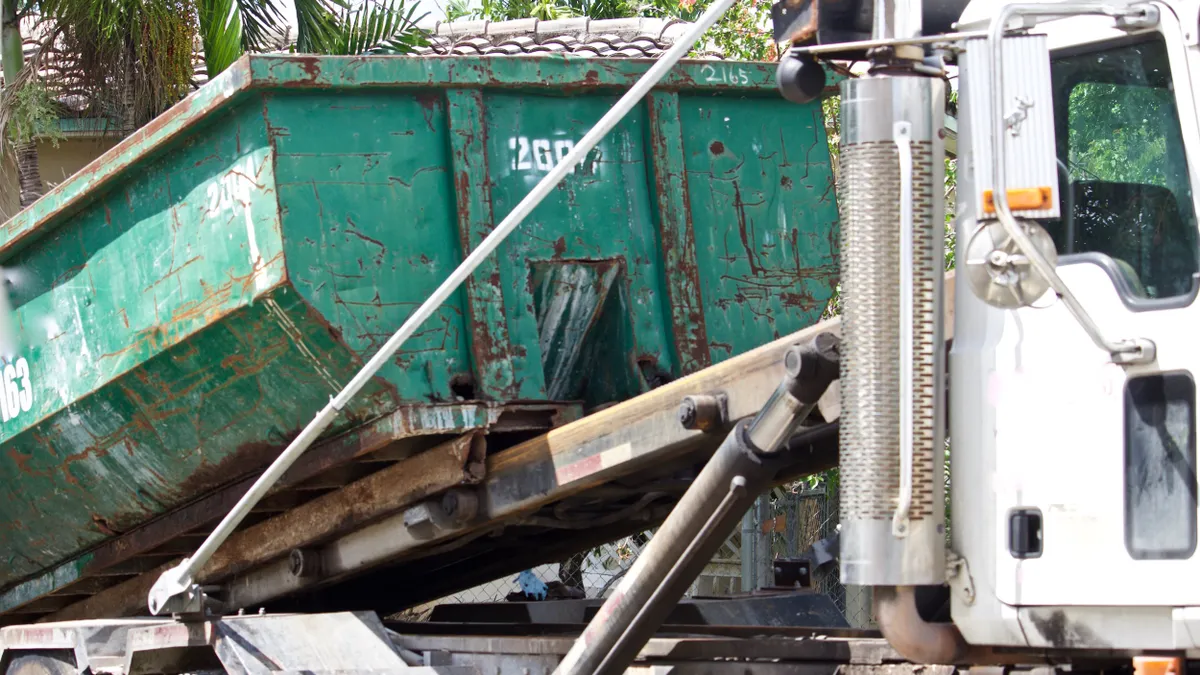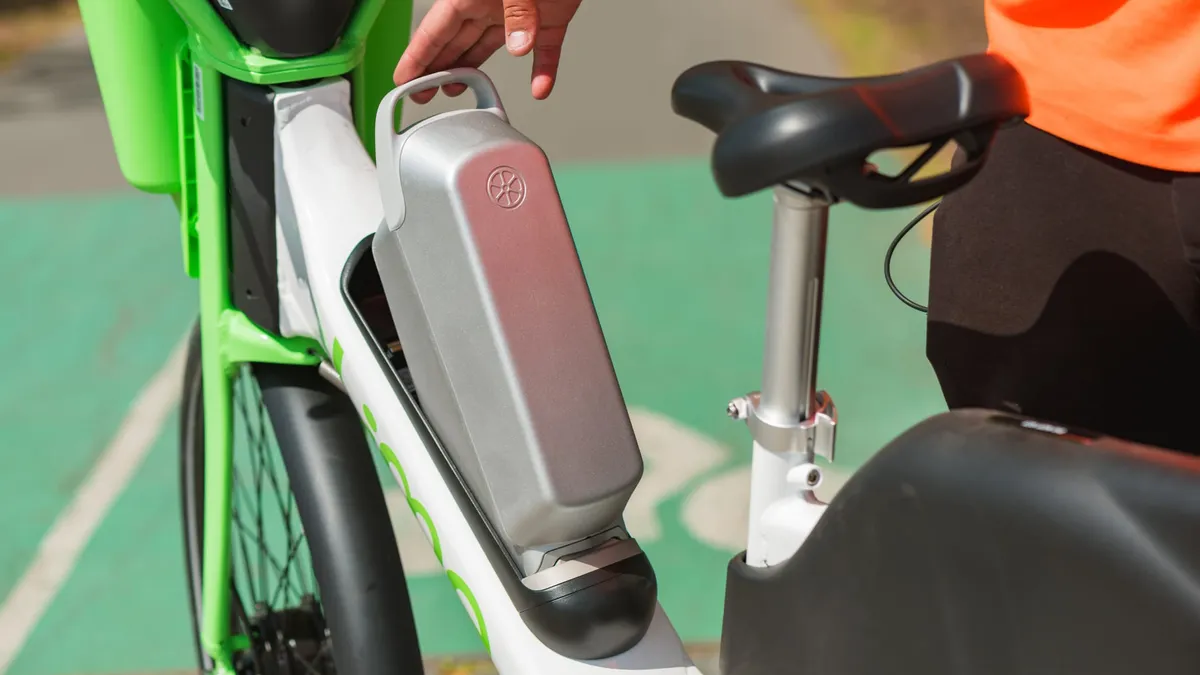Every few years, Delaware County in Pennsylvania faces a familiar issue for communities all over the country: waste from election mailers, stickers and yard signs.
“In the span of one day, it turns from a purpose to trash,” said Rebecca Yurkovich, sustainability and resilience manager for the Delaware County Office of Sustainability. “The day after the election, it immediately becomes almost blight in that community.”
Yurkovich said heavy rains can sometimes knock yard signs out of the ground and they may block drains or become road hazards. While the U.S. doesn’t track the management of this material specifically, it’s ubiquitous. In addition to this year’s presidential election, 468 seats in the U.S. Senate and House of Representatives are up for election; along with various state and local races, as well as ballot measures.
More than 80 countries, including the U.S., are voting in 2024 and people around the world are raising concerns about the waste involved. South Korea expected more than 1,740 metric tons of discarded banners from its April elections. In Ireland, concerns arose over posters covering road signs and forcing cyclists out of bike lanes. During the 2022 elections in the Philippines, 254 metric tons of election garbage were collected, 20% more than during the 2016 elections.
Two weeks before Mexico’s presidential elections in June, Greenpeace activists took some of the banners and posters covering Mexico City and returned them to the offices of the responsible political parties. The election authority of Mexico City reported that 45 metric tons of election waste had been cleaned up a month after the election. That figure covered only six of the city’s 16 boroughs.
In the U.S., ahead of the Nov. 5 election, local governments have sprung into action by making preparations to manage the material through recycling drives and also encouraging reuse when possible.
Do political yard signs work?
Election waste has far-reaching environmental effects, according to the Environmental Paper Network North America, a network of organizations working toward pulp and paper sustainability across the global supply chain.
Most yard signs are likely not recycled, said Kim Porter, resource and development coordinator for EPN North America. She said the best course of action to reduce waste is for campaigns to not produce the materials in the first place.
Lawn signs increase vote share by an average of 1.7%, according to 2015 research from Columbia and other universities. But they’re far from the most cost-effective promotional method. Another 2015 study from Yale and Columbia universities found that it cost $47 to produce a vote by distributing leaflets and $91 to $137 through direct mail. Campaigning door to door cost $31 per vote.
Porter hopes campaigns consider their environmental footprint and look at reducing their election waste. She also encouraged public policy that limits campaign mailers.
“There are more effective ways to influence voters, including going out and speaking at town halls and actually engaging with people face-to-face,” she said. “That creates better relationships and is really making a difference in getting people to vote for them as opposed to these very short-lived, wasteful products that cost the campaign a lot of money.”
The challenges of recycling election trash
Some local governments in the U.S. go to special lengths to recycle election waste.
Delaware County held its first event to collect political and other yard signs in November 2022. Since then, it has held three more events for general elections and primaries. The county collects from the public and coordinates with campaigns who drop off hundreds of unused signs at a time.
Yurkovich said communities should partner with their local board of elections and ensure that all political parties receive the same invitation to participate in recycling programs.
Delaware County’s events, which accept corrugated plastic signs and metal stakes, have collected a total of 5 tons of plastic and metal for recycling.
“When you see it all bound up in a truck, it's crazy to think all of that would have been going to a landfill,” Yurkovich said.
Finding a company that would recycle the signs, rather than throw them away, was difficult. Delaware County uses a recycler that is over two hours away. The company was transparent about how materials are processed all the way to the point of sale, Yurkovich said. She encouraged any local government looking to implement election recycling to do their due diligence when selecting processing facilities by asking what happens to the material and for guarantees that it will be recycled.
Other governments incentivize candidates to clean up their own election trash. Bethel Township in Delaware County requires candidates to apply for a permit. The town charges a $25 deposit for every 100 political signs. If the signs aren’t removed within 30 days after election day, Bethel keeps the deposit and uses it toward cleanup expenses.
In Florida, Seminole County and the local League of Women Voters chapter partnered with plastic recycling company PureCycle. Together they collected nearly 800 pounds of campaign signs following a recent primary election and plan to collect more after the general election. PureCycle said the signs will be recycled into resin for new products and packaging.
Austin, Texas, accepts signs and stakes year-round at its drop-off recycling center. Austin Resource Recovery began collecting signs in 2020. During that election, it collected just under one ton of yard signs, said Assistant Director Ron Romero.
A vendor melts the plastic campaign signs and sells the material to manufacturers. The city recycles metal stakes with the rest of its scrap metal. A vendor also composts untreated wood and sells the finished product to the public. Habitat for Humanity and other organizations accept treated wood that people don’t want to reuse themselves.
Creative reuse ideas
As managing election waste continues to be an issue, some governments and organizations are turning to reuse as another option.
Two days after the election, the incoming mayor of Mexico City announced that she would collect her election trash and make it into construction materials for her promised community centers. An opposing mayoral candidate said his banners would be made into reusable bags. As of July, neither political party reported their progress on these goals, according to the Mexican news outlet Expansión Política.
In Bangladesh, elections in January generated tons of posters, banners, cards and leaflets. So the nonprofit Bidyanondo Foundation turned some of that into notebooks for 1,000 children in their orphanages, schools and learning centers.
In the U.S., some local governments encourage people to reuse their signs and stakes. People can repurpose political signs for garage sales, birthday parties and other events, Austin’s Romero said. Yurkovich of Delaware County said campaigns could avoid printing election dates on their signs in order to make them more evergreen.
In the meantime, local governments are getting ready for the next deluge of trash after Election Day.
“I'm sure there are people thinking, 'Oh, well, how much harm can one sign do?'” Yurkovich said. “Multiply that by the hundreds or the thousands and then do that every year. I'm sure it adds up in terms of just the people power or public works staff that are then tasked with going to pick that up.”





















